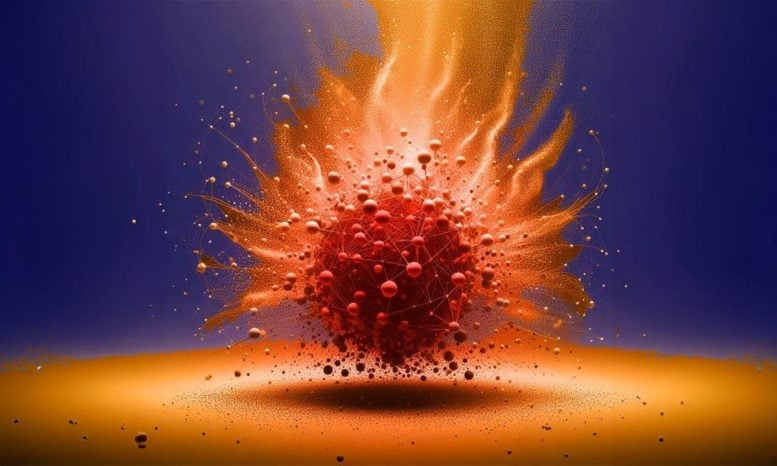by

Artist’s illustration of the spray of particles produced by the collision of two heavy atoms. As the hot subatomic soup cools, the newly formed particles fall into space. Copyright: Joseph Dominikus Lapp, editor
Scientists have recreated the extreme conditions of the early universe in particle accelerators, revealing surprising insights into the formation of matter.
New calculations show that up to 70% of some particles may arise from later interactions rather than from the initial quark-gluon soup that formed immediately after the interaction. Big BangThis discovery challenges previous assumptions about the timeline of matter formation and suggests that much of the matter around us formed later than expected. By understanding these processes, scientists can better interpret the results of collision experiments and improve their knowledge of the origins of the universe.
Recreating the harsh conditions of the early universe
The early universe was 250,000 times hotter than the core of the sun. That’s far too hot to form the protons and neutrons that make up the matter we see in everyday life. Scientists are trying to recreate the conditions of the early universe in particle accelerators by smashing atoms together at nearly the speed of light. Measuring the amount of particles raining down on the universe lets scientists understand how matter is formed.
The particles that scientists measure could have formed in different ways: from the original soup of quarks and gluons or from later interactions. These later interactions began 0.000001 seconds after the Big Bang, when composite particles made of quarks began interacting with each other. A new calculation finds that up to 70 percent of some of the particles measured are from these later interactions, rather than from interactions similar to those that occurred in the early universe.
Understanding the origins of matter
This discovery improves scientific understanding of the origins of matter. It helps determine how much of the matter around us was formed in the first few fractions of a second after the Big Bang, compared with how much was formed in later interactions as the universe expanded. This finding suggests that much of the matter around us was formed later than expected.
To understand the results of collision experiments, scientists must exclude particles formed in later reactions. Only those formed in the subatomic soup reveal the early conditions of the universe. This new calculation shows that the number of measured particles formed in the reactions is much higher than expected.
The importance of subsequent reactions in particle formation
In the 1990s, physicists realized that certain particles are formed in large numbers in subsequent interactions after the early formation of the universe. Particles called D mesons can interact to form a rare particle called carmonium. Scientists have not agreed on how significant this effect is. Because carmonium is so rare, it is difficult to measure.
However, recent experiments provide data on the number of collisions produced by carmonium and D mesons. Yale University Duke University used the new data to calculate the strength of this effect. It turns out to be much larger than expected. More than 70 percent of the carmonium measured could be formed in the reactions.
Implications of Understanding the Origins of Matter
As the hot soup of subatomic particles cools, it expands into a ball of fire. And all this happens in less than a hundredth of the time it takes light to travel across the cornSince it’s so fast, scientists aren’t entirely sure how the fireball expands.
The new calculations show that scientists don’t necessarily need to know the details of this expansion. However, the collisions produce a large amount of carmonium. The new result brings scientists one step closer to understanding the origins of matter.
Reference: “J/ψ Hadronic Regeneration in Lead+Lead Collisions” by Josef Dominikus Lapp and Bernt Müller, October 11, 2023, Physics of letters B.
doi: 10.1016/j.physletb.2023.138246
This work was supported by the Department of Energy’s Office of Science, Nuclear Physics Program. The authors also acknowledge hospitality and financial support during their stay at Yale University.

“Beer aficionado. Gamer. Alcohol fanatic. Evil food trailblazer. Avid bacon maven.”
